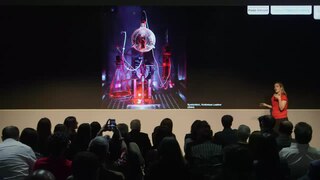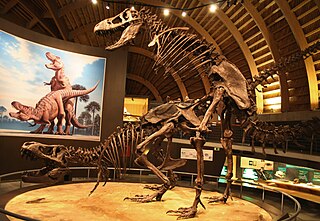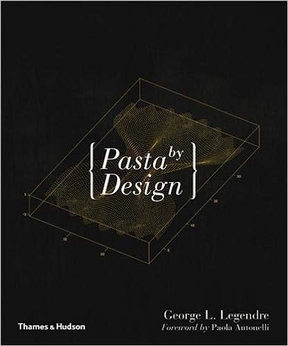
The Museum of Modern Art (MoMA) is an art museum located in Midtown Manhattan, New York City, on 53rd Street between Fifth and Sixth Avenues.

In computing, a zooming user interface or zoomable user interface is a graphical environment where users can change the scale of the viewed area in order to see more detail or less, and browse through different documents. A ZUI is a type of graphical user interface (GUI). Information elements appear directly on an infinite virtual desktop, instead of in windows. Users can pan across the virtual surface in two dimensions and zoom into objects of interest. For example, as you zoom into a text object it may be represented as a small dot, then a thumbnail of a page of text, then a full-sized page and finally a magnified view of the page.
Critical design makes aspects of future physically present to provoke a reaction. "Critical design is critical thought translated into materiality. It is about thinking through design rather than through words and using the language and structure of design to engage people ..". It is often assumed to be related to the critical theory and the Frankfurt School, but it is neither; rather, it is a form of critical thinking.

The Sacco chair, also called a bean bag chair,beanbag chair, or simply a beanbag, is a large fabric bag, filled with polystyrene beans, designed by Piero Gatti, Cesare Paolini and Franco Teodoro. The product is an example of an anatomic chair, as the shape of the object is set by the user. “[The Sacco] became one of the icons of the Italian anti-design movement. Its complete flexibility and formlessness made it the perfect antidote to the static formalism of mainstream Italian furniture of the period,” as Penny Spark wrote in Italian Design – 1870 to the Present.

Achille Castiglioni was an Italian architect and designer of furniture, lighting, radiograms and other objects. As a professor of design, he advised his students "If you are not curious, forget it. If you are not interested in others, what they do and how they act, then being a designer is not the right job for you."

Paola Antonelli is an Italian architect, curator, author, editor, and educator. Antonelli is the Senior Curator of Architecture and Design at the Museum of Modern Art (MoMA), New York, where she also serves as the founding Director of Research and Development. She has been described as "one of the 25 most incisive design visionaries in the world" by TIME magazine.
Eyebeam is a not-for-profit art and technology center in New York City, founded by John Seward Johnson III with co-founders David S. Johnson and Roderic R. Richardson.

Satyendra Pakhalé is a designer, industrial designer and architect. He realizes projects from industrial design, applied research to design vision of the future, technologically challenging product development, manufacturing, highly crafted pieces, exhibitions and architecture. He works in the fields of product design, including consumer electronics, health care, aviation, mobility, home appliances, furniture, digital products & computers, and interior design and architecture. In 2008, he was selected as one of L’Uomo Vogue magazine's 80 most influential creative people with vision worldwide in design and architecture. His works are in permanent collections of several museums worldwide.
Dunne & Raby is a London-based design studio established 1994.

Human–computer interaction (HCI) is research in the design and the use of computer technology, which focuses on the interfaces between people (users) and computers. HCI researchers observe the ways humans interact with computers and design technologies that allow humans to interact with computers in novel ways. A device that allows interaction between human being and a computer is known as a "Human-computer Interface (HCI)".

Exhibit design is the process of developing an exhibit—from a concept through to a physical, three-dimensional exhibition. It is a continually evolving field, drawing on innovative, creative, and practical solutions to the challenge of developing communicative environments that ‘tell a story’ in a three-dimensional space.

Neri Oxman is an American–Israeli designer and professor at the MIT Media Lab, where she led the Mediated Matter research group. She is known for art and architecture that combine design, biology, computing, and materials engineering.

An exhibition, in the most general sense, is an organized presentation and display of a selection of items. In practice, exhibitions usually occur within a cultural or educational setting such as a museum, art gallery, park, library, exhibition hall, or World's fairs. Exhibitions can include many things such as art in both major museums and smaller galleries, interpretive exhibitions, natural history museums and history museums, and also varieties such as more commercially focused exhibitions and trade fairs.
Hockett's Design Features are a set of features that characterize human language and set it apart from animal communication. They were defined by linguist Charles F. Hockett in the 1960s. He called these characteristics the design features of language. Hockett originally believed there to be 13 design features. While primate communication utilizes the first 9 features, the final 4 features are reserved for humans. Hockett later added prevarication, reflexiveness, and learnability to the list as uniquely human characteristics. He asserted that even the most basic human languages possess these 16 features.
Bzzzpeek.com is a website designed to appeal to young children that focuses on onomatopoeia from around the world. The site comprises recordings contributed by native speakers who imitate familiar sounds, such as animal calls and vehicle noises as they are typically rendered in their own language.
Matthew Kenyon is an American new media artist and director of the art practice, S.W.A.M.P.. Kenyon focuses on critical themes addressing global corporate operations, mass media, military-industrial complexes, and the liminal area between reality and artificial life.

Kacie Kinzer is an American designer and interactive artist. Her best known works are a series of cardboard "tweenbots", which were designed to get help from people, in order to complete their mission: crossing Washington Square Park. The bots were collected by the Museum of Modern Art and part of an exhibit on Design and Communication during 2011. Kinzer spoke at PopTech in 2009.
Listening Post is an artwork that visualizes Internet chatroom conversations. The work was created between 2002 and 2005 as a collaboration between the artist Ben Rubin and the statistician Mark Hansen.

Pasta by Design is a book by George L. Legendre, with a foreword by Paola Antonelli, and photography by Stefano Graziani. It is based on an idea by Marco Guarnieri.











